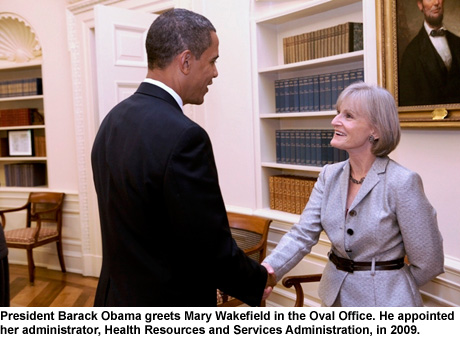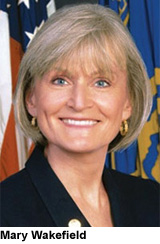I first provided patient care when I was in high school, working part-time in a small, rural hospital and nursing home in my hometown of Devils Lake, North Dakota, USA. Sometimes, I found myself rushing the five minutes it took to get across town to do back-to-back shifts after school. The lessons I learned about contributing in a meaningful way as a nurse started back then and have served me well through the years.

I learned early on that saying “I can’t” is rarely a good option. For that, I credit the nurses in those small-town health care facilities—always stepping in to guide and stepping up to help. Other major influences were my crop-duster dad, my schoolteacher mom, my seven siblings, and my friends and neighbors. From them I learned, if something was important to someone else or to me, I had to “find a way.”

It has often struck me that, in rural health care, necessity is the mother of innovation. On the Northern Plains in the late 1970s, far from the subspecialty expertise and high-tech medicine of major academic medical centers, I discovered that working together isn’t a novelty, and finding new ways of doing more with less isn’t a choice. Rather than considering challenges a problem, I learned that they drive creativity.
To Capitol Hill
Fast forward to 1987. With a relatively new doctoral degree in hand, I was offered a position as a legislative assistant in the Washington, D.C., office of a U.S. senator from North Dakota. I wasn’t at all sure I should take the job. After all, I was a tenured nursing professor at the University of North Dakota, with a good academic career path ahead of me. Not knowing anyone in North Dakota who could give me advice about working on Capitol Hill, I cold-called three national nursing organizations in Washington and left messages seeking advice.
One person called me back: Geraldine “Polly” Bednash, [PhD, RN, FAAN,] at the American Association of Colleges of Nursing. I don't remember what she said as much as how she said it. “Of course, you should take the job!” As if leaving rural America to go to faraway Capitol Hill was the obvious thing to do. But that conversation was a first step toward my becoming the first nurse to head the Health Resources and Services Administration (HRSA), an agency of the U.S. Department of Health and Human Services.
That experience—and all that followed—brought home two more key lessons for me: 1) the power and importance of mentors in young nurses’ lives and 2) the very important roles nurses can have across the spectrum of health care—from the bedside to the classroom to making and implementing health policy.
Nurses play key role
Today, in the United States, the link between health policy and access to health care has never been clearer. Nurses find themselves at a historic juncture in the evolution of health care delivery, a time when they can play a pivotal leadership role. In the near term, nurses can support the health of families and communities by serving as sources of much-needed information on how to access the health insurance coverage that the Affordable Care Act (ACA) offers.
I learned early on that saying “I can’t” is rarely a good option.Nurses have a well-deserved reputation as trusted sources of health information. Thus, they have an incredibly important role in informing people about the affordable health care coverage the ACA provides. With millions of individuals uninsured or underinsured across the nation, there are people all around us who can benefit from the enrollment that begins 1 October. This information is important to students, patients, families, neighbors, faith-based communities, and others.
I was reminded of that just recently. As I was leaving my office one evening—I suspect this scene is being played out across America—a security guard in our building stopped me and asked: “You have something to do with health care, right? I’ve heard there’s health insurance I might be able to afford. I have little kids, and I’m 44 years old. Do you know anything about that?”
He went on to say he hadn’t seen a provider in more than three years because he didn’t have insurance, but he knew it was very important for himself and for his children, who depended on him. We spoke for a few minutes about his options, and I told him how he could get more information.
As remaining provisions of the Affordable Care Act are implemented in 2014, nurses will be asked about details of the law, and they need to be prepared to talk about it, at work and, as I did, outside of work. But with all the inaccurate information out there, providing useful and correct information can be a challenge. I’m not saying nurses need to be experts in health insurance. Yet, it is extremely important for all of us to know where people can go for accurate information about the law and how it is being implemented in the states where they live.
A role for each of us
October 1 marks a very important juncture in the implementation of the ACA. On that day, Americans will be able to start signing up for private health insurance through the Health Insurance Marketplace for coverage that begins 1 January 2014. For many Americans, it will be the first opportunity they have had to obtain affordable coverage.
Although each state has different health insurance options, each state’s plan is accessible through one website:
healthcare.gov (in
Spanish; on
Facebook; on
Twitter). There, consumers can compare plans and learn if they or their family members qualify for a no-cost or low-cost plan—or a new tax credit that lowers monthly premiums. This is where nurses come in, doing what the profession is known so well for doing—connecting people with resources that help them get healthy and stay healthy.
You can send people to healthcare.gov and even help them sign up, or help them obtain state-based information through text messages and emails. You can direct patients to the Marketplace phone information line (800-318-2596), available 24/7, where questions can be answered in more than 150 different languages! You can organize nursing rounds at your workplace to talk about the Marketplace, using
tools available online for providers. By downloading videos, PowerPoint presentations, brochures, and other materials available at that site, nurses can obtain the information needed to effectively communicate how to access health insurance.
Nursing students can have a role in this, too, perhaps through community service projects at health fairs, clinics, or hospitals. Or they can join with students from other health professions and thus extend their reach.
These and other efforts are critical, because many of the people who stand to benefit most from access to affordable health insurance may not even know what is available. As a health care administrator and friend of mine back in North Dakota recently put it, “The only thing worse than not having insurance is being eligible for insurance but not knowing it.”
Nurses have an important opportunity to substantively improve the health of our communities by reaching out to help as many uninsured Americans as possible sign up for health insurance. In this effort, there is a role for each of us.
Investing in nurses
Beyond expanding access to health insurance coverage, the ACA is also increasing employment and educational opportunities for nurses. The Affordable Care Act—and the 2009 Recovery Act before it—made important new investments to expand access to primary and preventive health care in underserved communities through two HRSA programs: health centers and the National Health Service Corps (NHSC).
The HRSA-funded
health center network delivers primary and preventive care to about 21 million patients nationwide (4 million more than in 2008) at some 9,000 sites. These centers are an essential part of the national safety net, because they serve anyone who walks in.
Nurses are an important component of the health center workforce. Right now, about 16,000 nurses work at health centers across the country. Since the expansion began, health centers have added some 3,000 nursing positions, including 800 advanced practice nurses. And, as more people gain access to health insurance coverage, demand for primary care services at health centers will grow.
The
National Health Service Corps also strengthens access to care nationwide, by placing primary care providers in underserved areas for at least two years in exchange for paying down their student loans. The NHSC offers great opportunities for primary care nurse practitioners, certified nurse-midwives, and psychiatric nurse practitioners, among others.
Largely because of the Affordable Care Act, the ranks of the Corps have grown from about 3,600 clinicians to more than 8,000 since 2008. The number of nurse practitioners in the NHSC has risen to 1,600, and the number of certified nurse-midwives has grown to more than 200. Through the ACA, these investments will continue through 2015.
Through a similar program, nurses can get scholarships and loan repayment in return for service in health care facilities in underserved communities. We call it the NURSE Corps, and close to 3,000 nurses are taking advantage of this program.
The ACA also made additional investments in
nurse education programs that HRSA administers. Over the last four fiscal years (2010-13), we have committed more than $1 billion to educate new nurses and prepare them to deliver health care in redesigned health care settings.
For example, the ACA directed $15 million to nurse-managed health clinics, managed by advanced practice nurses and affiliated with schools of nursing. These clinics train new nurses while delivering primary care to vulnerable populations, such as public housing residents. The ACA also directed $31 million to prepare more primary care advanced practice nurses and $200 million for graduate nurse education programs that prepare APRNs for roles in coordinating care.
As the contours of redesigned health care emerge, nurses can look forward to a multitude of new opportunities. But for the very near future, regardless of where nurses work or live, they can help meet an overwhelming need that millions of people have—to get accurate information about (and the peace of mind that comes with) affordable health insurance coverage. RNL
Mary Wakefield, PhD, RN, FAAN, was named administrator of the Health Resources and Services Administration (HRSA) by President Barack Obama on 20 February 2009. HRSA is an agency of the U.S. Department of Health and Human Services. Wakefield joined HRSA from the University of North Dakota (UND), Grand Forks, where she was associate dean for rural health at the School of Medicine and Health Sciences. In the 1990s, she served as chief of staff to two U.S. senators from North Dakota: Kent Conrad (D) and Quentin Burdick (D).